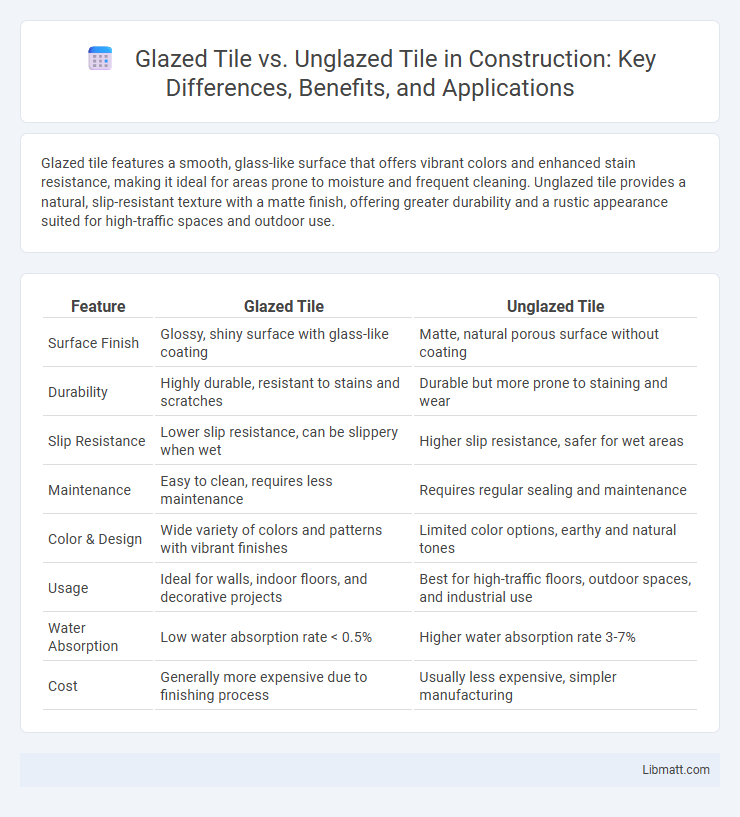Glazed tile features a smooth, glass-like surface that offers vibrant colors and enhanced stain resistance, making it ideal for areas prone to moisture and frequent cleaning. Unglazed tile provides a natural, slip-resistant texture with a matte finish, offering greater durability and a rustic appearance suited for high-traffic spaces and outdoor use.
Table of Comparison
| Feature | Glazed Tile | Unglazed Tile |
|---|---|---|
| Surface Finish | Glossy, shiny surface with glass-like coating | Matte, natural porous surface without coating |
| Durability | Highly durable, resistant to stains and scratches | Durable but more prone to staining and wear |
| Slip Resistance | Lower slip resistance, can be slippery when wet | Higher slip resistance, safer for wet areas |
| Maintenance | Easy to clean, requires less maintenance | Requires regular sealing and maintenance |
| Color & Design | Wide variety of colors and patterns with vibrant finishes | Limited color options, earthy and natural tones |
| Usage | Ideal for walls, indoor floors, and decorative projects | Best for high-traffic floors, outdoor spaces, and industrial use |
| Water Absorption | Low water absorption rate < 0.5% | Higher water absorption rate 3-7% |
| Cost | Generally more expensive due to finishing process | Usually less expensive, simpler manufacturing |
Introduction to Glazed and Unglazed Tiles
Glazed tiles feature a glass-like coating that enhances durability, water resistance, and aesthetic appeal, making them ideal for indoor applications like kitchens and bathrooms. Unglazed tiles consist of natural clay or other materials without a protective surface layer, offering better slip resistance and a more rustic, textured look suitable for outdoor or high-traffic areas. Understanding these differences helps you choose the right tile type for your specific design and functional needs.
Composition and Manufacturing Process
Glazed tiles feature a glass-like coating fused onto the surface during firing, created by applying a liquid glass mixture that melts and bonds to the tile body, enhancing durability and color vibrancy. Unglazed tiles consist entirely of dense clay or porcelain, fired at high temperatures without any glassy surface layer, resulting in a more porous, textured finish that emphasizes natural material properties. The manufacturing process for glazed tiles involves an extra glazing and re-firing step, while unglazed tiles undergo a single firing, preserving their raw, earthy composition and making them more slip-resistant.
Visual Appearance and Aesthetics
Glazed tiles offer a shiny, smooth finish with vibrant colors and intricate patterns, enhancing the visual appeal of any space. Unglazed tiles provide a natural, matte look with muted tones and a textured surface, creating an earthy, rustic charm. Your choice depends on whether you prefer a polished, decorative style or a more understated, organic aesthetic.
Durability and Strength
Glazed tiles feature a protective glass-like coating that enhances their resistance to scratches, stains, and moisture, making them highly durable for indoor applications. Unglazed tiles, often made from porcelain or natural stone, offer superior strength and wear resistance due to their dense, compact structure, ideal for high-traffic areas or outdoor use. Your choice should consider the balance between aesthetic preferences and the required durability, with unglazed tiles generally providing greater long-term toughness under heavy use.
Water and Stain Resistance
Glazed tiles feature a durable, glass-like coating that provides superior water and stain resistance, making them ideal for high-moisture areas such as kitchens and bathrooms. Unglazed tiles, often more porous and matte in finish, require sealing to enhance their resistance to water and stains, as they tend to absorb liquids more readily. Selecting glazed tiles ensures easier maintenance and long-term durability against moisture-related damage compared to unglazed options.
Slip Resistance and Safety
Unglazed tiles offer superior slip resistance due to their natural, textured surface that provides better traction even when wet, making them ideal for high-traffic or outdoor areas. Glazed tiles have a smooth, glossy finish that can become slippery, especially when exposed to water or oil, posing higher safety risks. For environments requiring enhanced safety measures, unglazed tiles are the optimal choice to reduce slip hazards.
Maintenance Requirements
Glazed tiles feature a smooth, protective coating that resists stains and requires minimal cleaning, making them ideal for low-maintenance spaces. Unglazed tiles, while more porous and prone to absorbing dirt, demand regular sealing and more frequent cleaning to maintain their appearance and durability. Choosing glazed tiles can reduce Your upkeep efforts, especially in high-traffic or moisture-prone areas.
Cost Differences
Glazed tiles typically cost more than unglazed tiles due to the additional manufacturing processes such as glazing and firing that enhance their appearance and durability. Unglazed tiles generally have a lower price point, offering a budget-friendly option while still providing strong wear resistance, especially for outdoor or high-traffic areas. When choosing between glazed and unglazed, your decision should consider both the upfront cost and the long-term maintenance expenses to match your project's budget effectively.
Best Applications and Use Cases
Glazed tiles, known for their smooth, glossy surface and stain resistance, are best suited for indoor applications such as bathroom walls, kitchen backsplashes, and low-traffic residential floors where aesthetic appeal and easy cleaning are priorities. Unglazed tiles, with their porous, textured surface and superior slip resistance, excel in high-traffic areas, outdoor patios, and commercial spaces requiring durability and enhanced traction. Both tile types offer functional versatility, but glazed tiles prioritize decorative value while unglazed tiles emphasize performance in rugged or moisture-prone environments.
Pros and Cons Summary
Glazed tiles offer a durable, water-resistant surface with vibrant colors and easy maintenance, making them ideal for kitchens and bathrooms, but they can be slippery and prone to chipping. Unglazed tiles provide a rustic, natural appearance with excellent slip resistance and better wear durability, suitable for high-traffic areas, though they require regular sealing and can be more challenging to clean. Choosing between glazed and unglazed tiles depends on specific needs like aesthetics, safety, and maintenance preferences.
Glazed tile vs Unglazed tile Infographic

 libmatt.com
libmatt.com